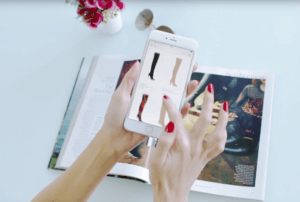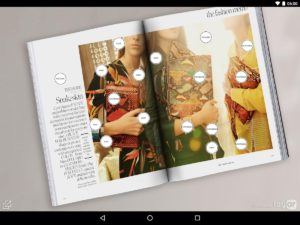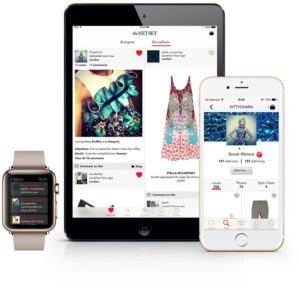When it Comes to Digital, Net-a-Porter is Keeping Luxury Retail on its Heels

Innovation in digital technology is the latest trend in luxury retail.
The rapid increase in digitalization has changed the business environment across industries and geographies dramatically. Within the retail channel, digitalization has brought unique opportunities and threats, altering the ways in which brands connect to and interact with consumers. While many brands have long considered a robust digital presence as a necessity, the issue of whether or not to go digital becomes more complex when it comes to luxury retailers. For these companies, digital’s free-flow of information runs counter to their historic reliance upon an exclusive, tightly-controlled brand image to retain their aspirational appeal.[1]
Benefitting from their ubiquitous brand equity, most luxury retailers have been slow to embrace digitalization, instead relying upon conventional methods such as magazine advertisements to engage with customers.[2] However, the proliferation of the internet has drastically changed consumer purchasing habits – and Net-a-Porter has emerged to capitalize upon this trend in the luxury space.
Net-a-Porter, a digital luxury fashion retailer, has disrupted the traditional luxury business model by enriching the customer shopping experience. By analyzing the ways in which customers are interacting with brands as well as studying their changing consumption and purchasing habits, the company has created a unique, seamless omni-channel presence across a variety of mediums in mobile, tablet and desktop.
Analyzing a study of 10,000 of its most valuable clients, Net-a-Porter realized that 88 percent of those surveyed preferred to find fashion inspiration via fashion magazines, with 80 percent preferring print media.[3] Rather than forcing consumers to convert to a new medium to receive this information, Net-a-Porter responded with an updated version of the traditional print magazine – PORTER.
Upon first glance, PORTER may seem like any other fashion magazine; however, as the saying goes, you shouldn’t judge this book by its cover.
PORTER allows readers to instantly shop what they read, and in most major cities both domestically and internationally, to have their purchases arrive the same or next day. Upon opening its glossy pages, the reader is given directions on how to shop the magazine.
The first instruction is to download the Net-a-Porter app, which is equipped with a scanner that enables the reader to hover his or her phone over any page in the issue. Upon doing so, a ‘shop’ icon will appear, displaying the brand, price, and a ‘buy’ button for any items available from Net-a-Porter. It also displays other color options the item may come in, as well as other related items on the site.[4]
PORTER offers many other interactive features as well. For instance, the ‘find’ label brings readers to a topic page featuring other items in that category; ‘see more’ allows readers to explore all of the items displayed by the model, and ‘concierge’ allows readers to connect with the company’s 24-hour concierge service to find a specific item in the magazine that is not available in the company’s e-commerce store.
The company’s strategy with PORTER has thus far been successful in getting consumers to engage with the content. In a 2015 reader survey, Porter found that items were scanned 85,000 times, representing an interaction rate of approximately 78 percent.[5]
Through PORTER, Net-a-Porter was able to combine customer’s preferred medium of finding content with their increasingly preferred way of purchasing content, creating a unique and interactive buying experience.
Net-a-Porter has recently further expanded into innovative digital technologies, tapping into the social media trend with the launch of its social network, the Net Set. Through creating a profile on this platform, users gain access to a live feed of globally trending fashion items. They are also able to follow friends, celebrities, trendsetters, and “style tribes” to see which items people are browsing, posting as style inspiration, and ultimately purchasing from Net-a-Porter’s current stock of items. In addition, users are able to upload their own personal photos to the site and receive recommendations of matching clothes and accessories.[6]
Through PORTER and the Net Set, Net-a-Porter has found ways to challenge luxury retail’s traditional model of engaging with customers. As the relationship between brands and customers evolves towards more interactive mediums, Net-a-Porter has positioned itself ahead of the curve among luxury retailers. Going forward, Net-a-Porter remains dedicated to innovating new technology platforms to interact with customers in unique ways. Mobile remains the company’s main focus, as 95% of luxury shoppers are mobile-equipped.[7] As such, I believe Net-a-Porter should continue to further integrate image recognition into their rapidly expanding mobile offering. Doing so, the company can ensure it has the digital platform necessary to reach consumers and deliver products through the mechanisms that customers prefer.
Word Count: 752
[1] Morisset, Denis. “Are Luxury Brands Disrupted by the Digital Revolution?”, ESSEC Business School, May 15, 2015, http://www.essec.edu/en/news/are-luxury-brands-disrupted-digital-revolution, accessed November 2016.
[2] Morisset, Denis. “Are Luxury Brands Disrupted by the Digital Revolution?”, ESSEC Business School, May 15, 2015, http://www.essec.edu/en/news/are-luxury-brands-disrupted-digital-revolution, accessed November 2016.
[3] Lazauskas, Joe. “The New Model: How Net-a-Porter Keeps the Fashion Industry on Its Heels”, September 3, 2015, https://contently.com/strategist/2015/09/03/the-new-model-how-net-a-porter-keeps-the-fashion-industry-on-its-heels, accessed November 2016.
[4] Milnes, Hilary. “How Net-a-Porter built a digital shopping experience in a print magazine”, February 18, 2016, http://digiday.com/brands/net-porter-built-digital-shopping-experience-print-magazine, accessed November 2016.
[5] Milnes, Hilary. “How Net-a-Porter built a digital shopping experience in a print magazine”, February 18, 2016, http://digiday.com/brands/net-porter-built-digital-shopping-experience-print-magazine, accessed November 2016.
[6] Codinha, Alessandra. “Taking Net-a-Porter’s New Social Network for a Test Drive”, May 6, 2015, http://www.vogue.com/13259351/new-net-a-porter-app-the-net-set, accessed November 2016.
[7] YOOX Net-a-Porter Group, Roadshow Presentation, November 2016, http://cdn3.yoox.biz/cloud/ynap/uploads/2016/11/1479317387667_YNAP_ROADSHOW_PRESENTATION_9M2016_vPublished_lowres.pdf, accessed November 2016.








Very interesting post! It is particularly interesting to see how net-a-porter is integrating its online and offline channel, to provide more of an integrated experience. Although many luxury companies have now given in and also sell online, I am still not sure, if it does not dilute their image of exclusivity and harms their selective distribution. I am also curious to know, if it is worthwhile for luxury brands to sell through net-a-porter, since they are forgoing a significant part of their margin and essentially have the same technology on their website. In order to differentiate itself from the luxury brands, net-a-porter has to be very innovative in the future, to be one step ahead.
Thanks for writing! Want to respond to this comment. I’m also unsure about the dilution effect that luxury brands experience when they become so widely available on the internet. So I wonder if they should be leveraging their own proprietary apps to further the experience. But instead of a free/highly accessible app, it becomes something that requires an invite and then has multiple tiers. Perhaps it would be a way for the sales people of old fashion houses to interact with their clientele in an up-to-date high-tech manner. There could be a browsing/interaction platform, and special releases through parts of this app specifically, and ways to get special items (like the Chanel WOC that is frequently on waitlists). That would be a good way for these clients to experience the luxury brands on mobile and online but without devaluing their exclusivity.
Net-a-Porter seems to have done a great job integrating the latest technological innovations into their existing business model of selling clothes online. The thing I wonder however, is whether the company should establish some kind of brick and mortar presence to continue to grow the business and capture additional market share. E-commerce companies like Warby Parker and Bonobos which started as online only businesses have now started opening brick and mortar retail locations which serve as showrooms for the products (additional information can be found here: http://www.wsj.com/articles/warby-parker-bonobos-have-big-plans-for-physical-stores-1475767980). Do you think this is something that Net-a-Porter should consider doing in the future?
Completely agreed with the digital strategy of Net-A-Porter. Retail is no longer an “leisure activity” for today’s customers – it is a “lifestyle” and as such, retail touchpoints should be seamlessly integrated into all aspects of a customer’s life, whether it is through Net-A-Porter’s social network or its magazine scan function.
I do think that within the luxury retail world, however, customers need to interact with a product in person at some point in their purchasing decision cycle. Perhaps Net-A-Porter can partner with other companies to drive innovative, in-person selling strategies – thoughts that come to mind are a) partnering with companies like Microsoft or Apple to do a digital, pop-up shop; b) “shop in shop” partnership with a major retailer (i.e. Nordstrom); etc.
Great post!! Net-a-Porter is indeed ahead of the curve and seems to have landed on some very interesting ways to integrate print and digital. Indeed, it would not be surprising if all print magazines were instantly shoppable one day soon, as this seems like a natural progression in an industry where people are still dedicated to print but do much of their shopping online. I wonder also if Net-A-Porter could use the massive amounts of data on customer behavior to add some sort of personalization feature, whereby the site becomes a personal shopper by recommending items based on past purchases. A lot of websites already have a “recommended for you” list, but it seems to me there is room to make this feature more sophisticated.
The GILT co-founder, Alexis Maybank, is also taking on a similar approach in enabling users to purchase the same apparel that someone is wearing in a photo (http://fortune.com/2016/04/14/project-september-alexis-maybank/). The mobile-app is called Project September (www.projectseptember.com). Any fashionista on social media can post photos of themselves, and users can purchase that same outfit. A green dot will hover over those chic boots or leather jacket and you too can rock out the same fashion look. It will be interesting to see how fashion powerhouses like Net-a-Porter continue to compete on the tech front.
Interesting article! I think there is a lot of unique tech disruption going on in the fashion industry, particularly as we’ve seen a rise in the influence of fashion bloggers. I am particularly interested in (and an avid user of) Liketoknowit (http://liketoknow.it/login), which originally was just a company that allowed bloggers to monetize their blogs through affiliate links, but now allows you to “like” their instagram posts and get an email with links to everything they’re wearing in the picture.